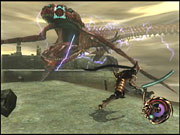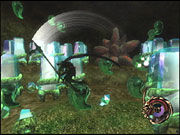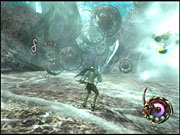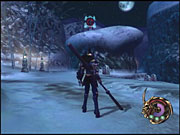A mystical, dreamlike world of sorcery and danger awaits in Otogi: Myth of Demons, a third-person action game set in feudal Japan in which you play as a resurrected swordsman ordered to cleanse the land of evil. Developed by From Software, which has a long track record of quirky games, Otogi is easily the company's most aesthetically pleasing game to date, and also one of its best. Superbly crafted production values (catered exclusively to the Xbox's hardware) and great gameplay that's tough but not impossible make for a game that's not just beautiful to look at, but entertaining and challenging as well. Otogi, whose premise is inspired by Japanese mythology, obviously isn't a game that everyone is going to gravitate to. But any Xbox owner looking for one of the best and most genuinely stylish action games so far this year should absolutely check it out.

Throughout Otogi, you play as Raikoh, a slender, silent man whose face never betrays any emotion--or any sign of life. Raikoh has been restored to the land of the living by an enigmatic princess whose goal, it seems, is to rid Japan of a demonic infestation. She is powerful enough to grant Raikoh immense strength--but that's all, and so you must guide this mighty swordsman through more than two dozen different levels, exorcising any demons that stand in his way all the while. Yet there's more to Otogi than just your typical battle of good versus evil. As Raikoh leaves pure destruction in his wake--he is so powerful that he can obliterate everything from massive tree trunks to entire houses--and as some of his demonic foes express regret and bitterness as they die by his hand, you'll see that Otogi has a very different tone to it than the typical hack-and-slash action game. Indeed, for a game that's filled with plenty of over-the-top action, Otogi has something remarkably subtle about it--almost a Zen-like quality, through the juxtaposition of the intense combat and the contemplative, philosophical speeches of the princess and some of Raikoh's enemies. Raikoh himself never says a word.
The gameplay borrows from a number of previous such games but somehow comes through with its own, unique feel. Raikoh can execute fast and heavy slashes and string together a few different types of combinations. He can also fire off different types of elemental magic once he acquires them. He can double jump in the air and can also glide forward short distances, almost exactly like in Sega's recent Shinobi game for the PlayStation 2. However, Raikoh can remain airborne almost indefinitely--while slashing in midair, he falls like a feather, and some of his flying strikes can be used to propel himself upward. This leads to some breathtaking midair confrontations later in the game, in which you and your foe will be dueling high up in the sky. Raikoh can even use his blade to reflect some enemy projectiles back at his foes.
Otogi has a few other twists. As mentioned, there is very little that Raikoh cannot destroy, and the game actually rewards you based on how much destruction you cause. Though some of Raikoh's midair strikes are designed to keep him aloft, others will send him crashing straight down with his weapons, obliterating whatever lies beneath. It's thrilling to run through the game's beautiful environments and lay waste to them in this fashion, especially since destroyed objects may leave behind for you various power-ups, weapons, magic, and more. You also need to be on the lookout for special talismanlike creatures that, when defeated, release power-ups that permanently increase Raikoh's health (beginning with the next level). Many of the stages have a number of secrets to find, and while most levels are only about five minutes long, they'll usually take you a number of tries to finish, and you can go back and replay them as much as you like in an effort to uncover all their hidden treasures.

As Raikoh wins battles, he'll gain experience levels and be rewarded with gold, with which he can purchase new weapons, magic, and accessories. He may equip one of each before going into a new level, and in particular, there's a great variety of weapons available. In addition to standard-length swords, he can wield massive two-handed swords, warhammers, magical staves, halberds, twin blades, and more. Raikoh's weapon won't just affect his attacks, but may also give him certain special abilities and may affect his movement speed and the height of his jumps. Sometimes there's a weapon that's best suited for a job, but you'll probably enjoy experimenting with them all.
The powers granted to Raikoh are not limitless--a slowly dissipating magic meter essentially imposes a time limit on each level, since once Raikoh's magic runs out, he'll lose many of his abilities and will quickly lose his remaining health. So he'll need to work quickly in each level, though by slaying foes and absorbing their souls, and by being conservative with his special abilities, he can keep from running out of magic before reaching his objective.
This serves to keep the missions fast paced, though the gameplay does have some minor issues. As can be the case with these types of games, the camera perspective can sometimes prevent you from seeing a nearby foe--you can lock onto individual enemies so that they never leave your field of vision, but this won't always keep you from getting blindsided. When you're not locked on, the right analog stick can rotate the camera, but it can't quite keep up with the action. You'll fare better by frequently pressing down on the left analog stick, which centers the perspective behind Raikoh--this works fine, but it can be a little cumbersome to keep having to do. Other than that, later in the game you'll come to rely on one particular combo in Raikoh's arsenal, which allows him to fire off a powered-up magical shot without having to charge up the shot as he normally would. The game's fairly sudden shift of focus from swordplay to magic isn't bad, but it would have been nice if Otogi better balanced out magic and close combat in the later levels. Also, some of the later stages reuse some of the earlier environments, though these environments appear so different from when you first saw them that you won't notice right away.

Though the missions in the game all involve eliminating demonic infestation, there's actually a lot of variety both to the settings of these missions and to the specific objectives. Sometimes Raikoh will need to defeat a powerful boss, such as a massive flying demon shaped like a caterpillar or an imprisoned demon god threatening to break free of its bonds. At other times, he'll need to find certain objects in the environment before his time runs out. A couple of occasions require Raikoh to protect a certain target, and a couple of others quite literally force Raikoh to race for his life. Since many of the missions are challenging and there are plenty of them, Otogi ends up being a good-sized game and will probably take 10 hours or so to play through the first time. As mentioned, there's some replay value to be found in revisiting the levels, though there's no multiplayer mode to be found here or anything of that nature. Still, purely as a single-player action game, Otogi certainly packs in a satisfying amount of material.
The mission objectives vary quite a bit, but one aspect of Otogi that remains constant is how beautiful it looks. That's a strong word, inappropriate to describe even some of the most graphically impressive games, but it's a fitting description of Otogi's highly detailed environments, which appear larger than life and are filled with soft ambient lighting, are often shrouded in mist, and look perfectly like something out of a storybook--the game's settings fit the mythological theme spot-on. And though they already look great from afar, the levels look even better as you smash them into splinters, crushing buildings and sending enemies flying through boulders and wooden archways and such. Raikoh himself has a very distinctive character design, with his fearsome-looking suit of armor and his flowing black hair, and many of his foes, particularly the bosses, also look great. There's even some terrific hand-painted artwork depicting all the various creatures in between missions. Those with progressive scan televisions can enjoy these graphics even more.
Occasionally, the game's frame rate slows down, particularly when Raikoh manages to cause a chain reaction of destruction, sometimes causing multiple stone pillars to crumble to the ground with a single stroke. Yet while frame rate issues detract from the visual quality of most games, here things tend to blur just as they slow down, lending even the frame drops a stylistic effect. At first glance, Otogi may not look remarkable, but it's one of the rare games available with a truly inspired artistic design.

This is true of the game's audio as well as its graphics. In fact, the audio is possibly even more impressive than the visuals. A hauntingly dissonant musical score, featuring traditional Japanese percussion and string instruments, fits the game extremely well and establishes the tone and setting even before you've begun play. This soundtrack, while not the sort of thing you're going to hum to yourself when you're not playing, is extraordinarily good. The game's sound effects, meanwhile, are a bit subdued--the sounds of Raikoh's slashes are perhaps a bit too muted, though his battle cries and the sounds of his enemies all sound just right. What's more surprising is the high quality of the game's English voice acting. Thankfully, Otogi features the original Japanese language track, which you might prefer for a more authentic feel--and yet the English voices are at least as good if not better, and like the rest of the game's presentation, they perfectly fit with the game's tone and style. Dolby Digital 5.1 support enhances the aural aspect of the game even further.
It's certainly true that without its remarkable production values, Otogi: Myth of Demons would be much less of a game. The action is quite well done and has a unique kind of feel to it, but alone it wouldn't have been enough to distinguish Otogi from many other games. Yet the remarkable production values are here--Otogi stacks up favorably against all the best-looking, best-sounding Xbox games yet. But unlike some of those and most other games, something about how the graphics and sound all fit together with the action makes this the sort of experience that's really enthralling, and at the same time, Otogi is filled with plenty of genuinely challenging and exciting sequences. As such, Xbox owners would be fortunate to add this game to their collections, or at least to play it.



